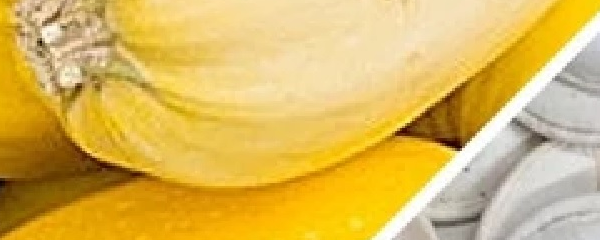

Quick Information
PROPER NAME
Cucurbita
COMMON NAME
Squash
TYPE
Annual
HARDINESS ZONE
2 to 9a (Annual)
GERMINATION
7-14 Days
MATURE SIZE
20-45cm Tall / 3-5m Wide
SUN EXPOSURE
Full Sun
SOIL TYPE
Well-Drained & Rich
SOIL PH
Neutral to Acidic (5.5 to 7)
Squash
There are two varieties of Squash in the Cucurbita family known by Summer and Winter Squash. These fruits are closely related to the Melon family and is a delicious addition to your garden. Squash will keep you well stocked up on your Vitamin A, with just a 1/4 cup making up your body’s daily needs.
Squash can be grown in bushes or, more commonly, with vines that will grow several meters in length. You’ll find large globe-like leaves on many varieties with prickly surfaces. Squash flowers can be a range of colours based on the type you’ve planted, whether yellow, orange or green. The majority of cultivars originated in North and Central America.
PLANTING SQUASH
DEPTH
1.5cm Deep
PLANT/ROW SPACING
60cm / 90cm
GERMINATION
7-14 Days
DAYS TO MATURITY
45-60 Days
PLANTING SEASON
Spring, Summer & Fall
Squash should be planted in well-drained, rich soil with plenty of compost at the base. Gardeners typically seed their Squash in groups of 3 on what’s known as a hill. These hills should be spaced approximately 3 – 5 meters apart, with 6 to 8 seeds planted 1.5 cm deep in the center of each mound. Once the seedlings have emerged, thin them to the recommendation for the species.
If you want to avoid the direct sow method, you can usually find seedlings in peat pots at your local Garden Center. Plant 3-5 pots depending on the species, and let nature help them take root through the peat pots.
Vines require regular watering and fertilizing in the summer months. Be on the lookout for fruit forming on your vines, and always put something underneath them to avoid direct contact with the soil. Keeping the fruit dry by placing 10 cm of straw under them will help prevent rotting.
PRUNING SQUASH
Most Squash plants will only offer 4 to 5 fruit per plant. Once the fruit has formed, pinch the vine off a couple of leaves down the vine to maximize nutrients. Doing this will allow more energy to be put directly into the fruit instead of pointless plant maintenance. Removing roots on vines past the fruit is nothing to worry about as they can survive without them. NEVER disturb the primary taproot of the plant, as this will terminate any growth.
CARING FOR SQUASH
LIGHT – Squash requires full sun and needs a minimum of 6 hours of direct sunlight a day. As much sun as they can get is alright as long as they don’t overheat.
SOIL – Your soil should be rich in organic material and well-drained. Neutral to acidic soil (5.5 to 7.0) is the ideal growing environment for your Squash.
WATER – NEVER let your seedlings dry out, as this will be fatal to the plants’ productivity. Once the leaves broaden, you’ll have to offer more water to the plants. It’s not uncommon for leaves to have a wilted appearance in the hottest part of the day and should revive as the sun goes down. If you find your leaves wilted in the morning, water your Squash immediately.
TEMPERATURE/HUMIDITY – Squash is very cold-sensitive, and your seeds will not germinate until your soil temperature is at least 70°C. Depending upon your region, this may stunt your growing season. It’s a good idea to start your Squash six weeks before the last frost. These plants often wilt in the hottest part of the summer. If they don’t revive in the evenings, consider offering them some shade.
FERTILIZER – Being a voracious feeder, you should start with a mixture of rich soil and compost at planting and add more in the middle of the growing season. Once the plant has blossomed, apply a liquid fertilizer or compost tea at two-week intervals.
VARIETIES OF SQUASH
SUMMER SQUASH
Summer squash would be varieties like Zucchini, Zephyr and Crookneck Squash. These varieties tend to have thinner, softer skins and perish more quickly. The advantage of these is that the entire vegetable is edible, including the skin.
WINTER SQUASH
Winter Squash would be varieties like Butternut, Pumpkin, Acorn, Hubbard and Spaghetti Squash. These varieties tend to have thicker skins that allow them to preserve well in a root cellar.
HARVESTING SQUASH
Use the colour of the skin to determine if it’s time to be harvested, as Squash will not ripen off the vine. The rind should be firm and glossy and sound hollow if tapped with your knuckles. For storing Squash over the winter, be sure to leave them on the vine until just before the first frost. When you finally severe it from the vine, use a sharp knife and leave at least 3 cm of the stem attached to the fruit.
PROPAGATING SQUASH
Squash can be started indoors about six weeks before the last frost date. Start 3 – 4 seeds in peat pots so you can transplant your seedlings with the entire container intact. Any root disturbance during the transplanting process can be fatal to the plant. Once the plants have sprouted, it’s time to thin to the best-looking two plants.
OVER-WINTERING SQUASH
Summer Squash doesn’t store well for extended periods, but before storing, be sure to let it cure for ten days in 25°C or warmer weather. However, Winter Squash can last several weeks to months if adequately prepared. Leave your Winter Squash for 10 to 14 days in 25 to 30°C temperatures in 80 to 85% relative humidity with good air circulation.
PESTS & DISEASES AFFECTING SQUASH
Your best defence against pests with Squash is prevention in the way of row cover. Place your row cover at transplant or sow and leave it in place until your plants start flowering. Always be on the lookout for pests and diseases regularly. Consider planting some plants like Cilantro, Dill or Sweet Alyssum to attract some Beneficial Insects to keep your pest population low. However, no matter what you do, you’ll likely have issues with your Squash. The most common problems to watch out for are Squash Vine Borers, Squash Bugs, Cucumber Beetles and Powdery Mildew.
Education, Tutorials, Planning & More…
Click Here to Return to the Main Page


